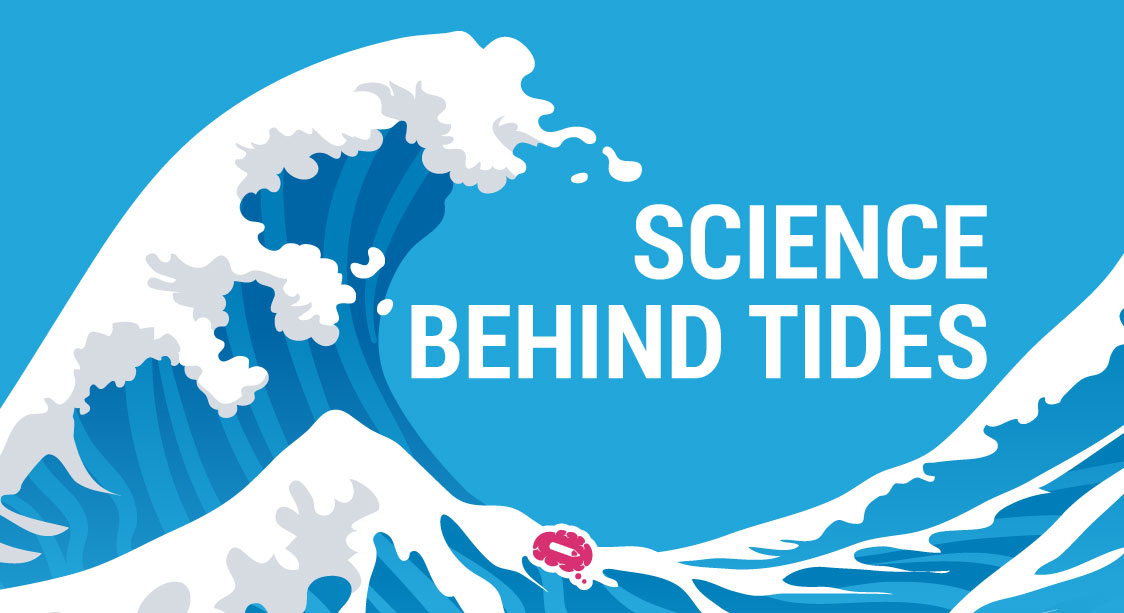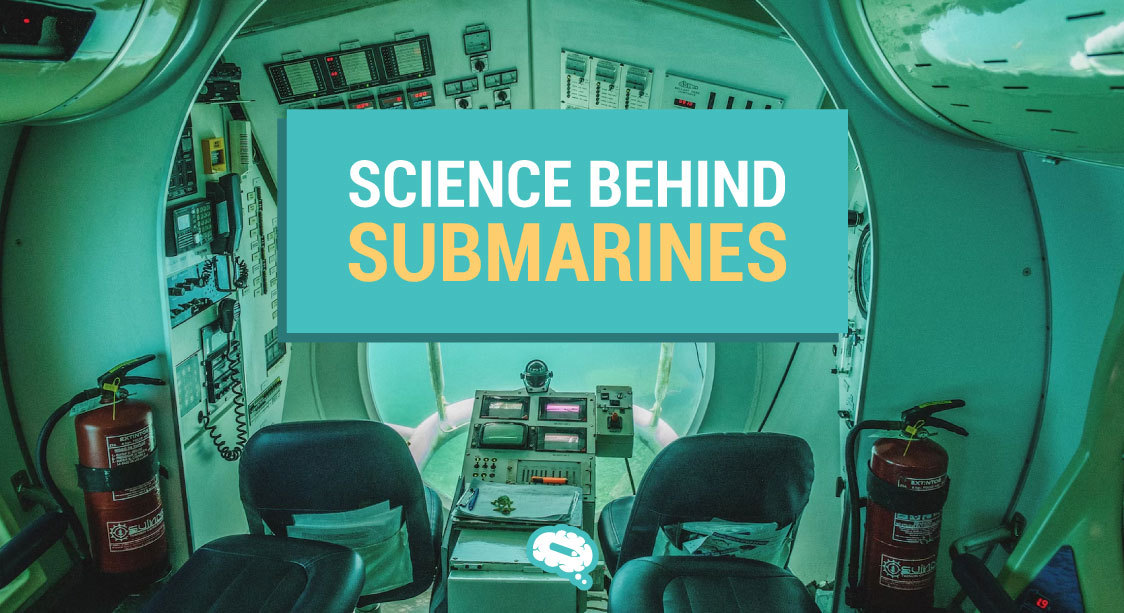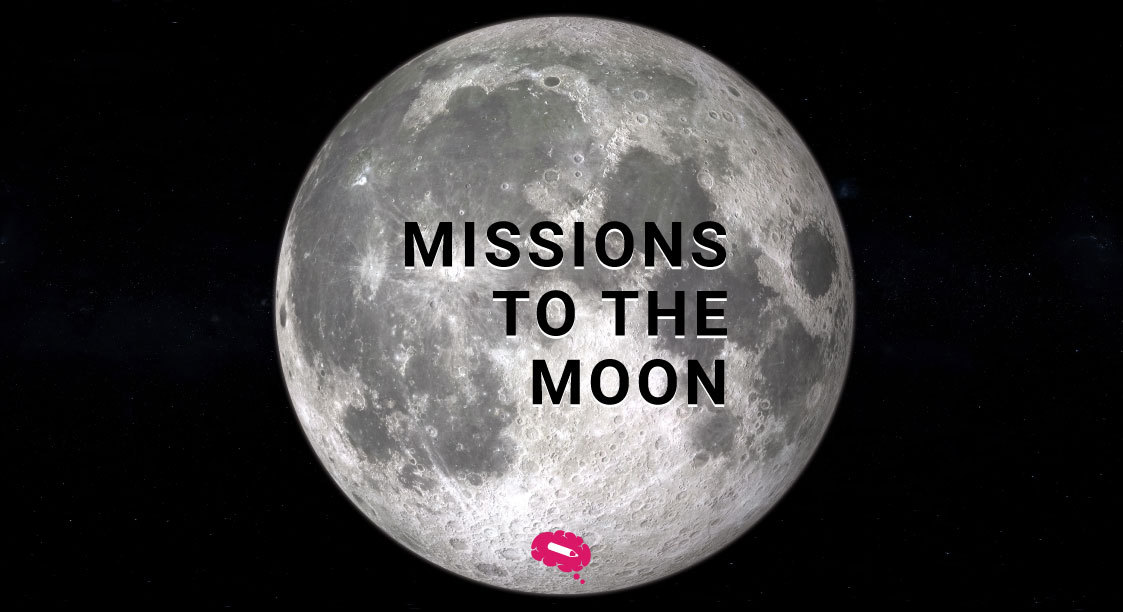Tides, the rhythmic rise and fall of sea levels, are fundamental to Earth’s natural processes. Caused primarily by the gravitational interactions between the Earth, the Moon, and the Sun, tides create the regular movement of water observed along coastlines. Understanding the science behind tides is important for various human activities, including navigation, fishing, and coastal management. Tides influence marine ecosystems and contribute to the planet’s overall climate system. This article describes how tides function, explaining the forces behind this important phenomenon and its big impact on our daily lives.
Understanding Tides
What Are The Causes Of Tides?
Tides are primarily caused by the gravitational forces exerted by the Moon and the Sun on Earth’s oceans. These forces create the regular rise and fall of sea levels that we observe as tides. The gravitational pull of the Moon and the Sun attracts the water in the Earth’s oceans, causing it to bulge outwards. The gravitational force is stronger on the side of the Earth closest to the Moon, creating a high tide in that area. Simultaneously, on the opposite side of the Earth, another high tide occurs due to the inertia of the water.
The Moon has the most significant influence on Earth’s tides. Its gravitational pull is the primary force creating the tidal bulges. As the Earth rotates, different areas of the planet move through these bulges, resulting in the regular cycle of high and low tides. The Moon’s position relative to the Earth changes slightly each day, leading to a tidal cycle that is about 24 hours and 50 minutes long.
Although the Sun’s gravitational pull on the Earth’s oceans is weaker than that of the Moon, it still plays a significant role in shaping tides. When the Sun, Moon, and Earth align during full and new moons, their combined gravitational forces create spring tides, which are higher high tides and lower low tides. Conversely, when the Sun and Moon are at right angles relative to the Earth, their combined gravitational forces partially cancel each other out, resulting in neap tides, which are lower high tides and higher low tides. The science behind tides helps clarify these complex interactions and their impact on tidal patterns.
Types of Tides
High Tide
High tide occurs when the sea level reaches its highest point in the tidal cycle. This happens due to the gravitational pull of the Moon and, to a lesser extent, the Sun, which causes water to bulge outwards on the side of the Earth closest to the Moon. Simultaneously, another high tide occurs on the opposite side of the Earth due to the inertia of the water. High tides typically occur twice a day, roughly 12 hours and 25 minutes apart.
Low Tide
Low tide occurs when the ocean’s water level reaches its lowest point along the shore. This happens because the gravitational pull of the moon and the sun affects the Earth’s water, causing it to bulge out in certain areas while receding in others. As the Earth rotates, different areas experience this bulging and receding, leading to the cyclical rise and fall of tides. During low tide, more of the shore and seabed are exposed, which can impact coastal activities such as fishing, boating, and beachcombing. It also reveals tide pools and marine life that are typically underwater.
Spring Tide
Spring tides are the highest high tides and the lowest low tides, occurring when the Earth, Moon, and Sun are aligned. This alignment happens during the full moon and new moon phases, roughly twice a month. During spring tides, the combined gravitational forces of the Moon and the Sun work together to exert a stronger pull on the Earth’s oceans, resulting in more extreme tidal conditions. These tides are called “spring tides” not because of the season but because the water “springs” higher.
Neap Tide
Neap tides are the moderate tides that occur when the Moon and the Sun are at right angles relative to the Earth, during the first and third quarters of the moon’s phases. During this alignment, the gravitational forces of the Moon and the Sun partially cancel each other out, leading to lower high tides and higher low tides. Neap tides also occur twice a month and are characterized by less extreme tidal conditions compared to spring tides.
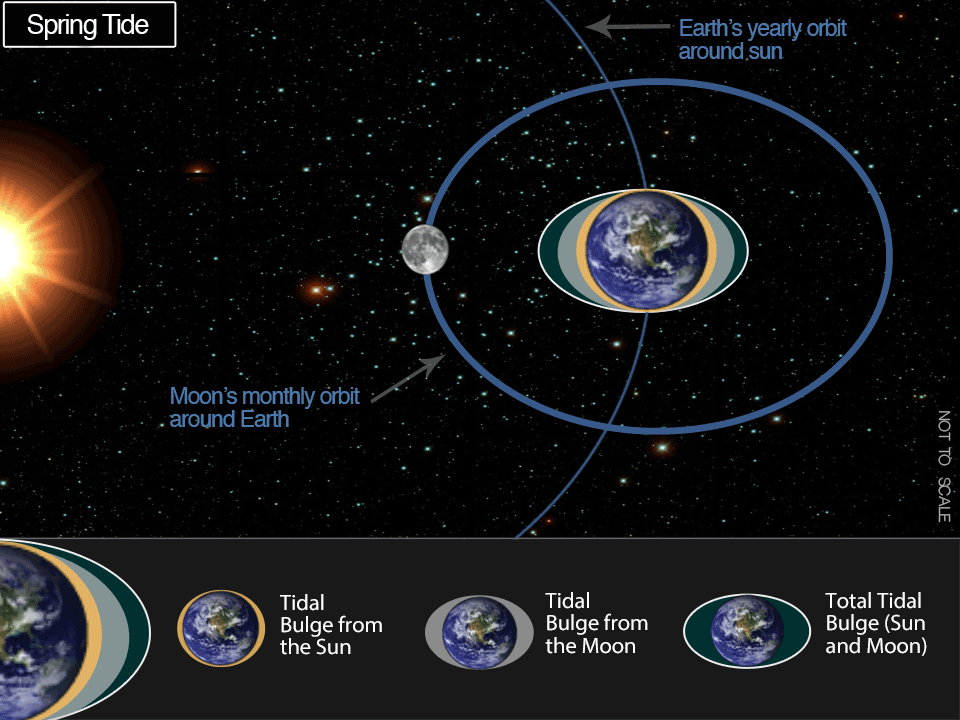
How Tides Work
Gravitational Pull
The Moon’s gravitational pull is the primary force responsible for creating tides on Earth. As it orbits our planet, the Moon’s gravity exerts a pull on the Earth’s oceans, causing water to bulge outward on the side facing the Moon, resulting in high tide in that region. Simultaneously, on the opposite side of the Earth, inertia resists this pull, creating a secondary bulge and another high tide. These tidal bulges shift as Earth rotates, resulting in approximately two high tides and two low tides every 24 hours and 50 minutes.
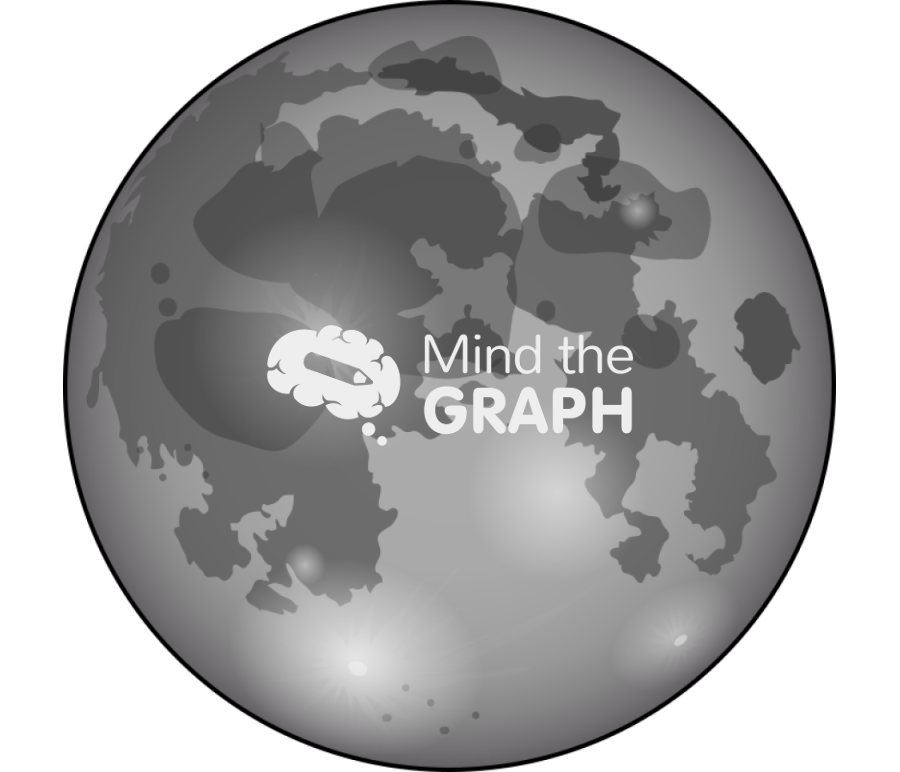
While the Moon’s gravitational influence dominates in creating tides, the Sun also plays a significant role. Although weaker due to greater distance, the Sun’s gravity affects Earth’s oceans. During new and full moons, the alignment of the Sun and Moon amplifies their gravitational forces, causing spring tides with higher highs and lower lows. Conversely, when they are at right angles relative to Earth, gravitational forces partially cancel, producing neap tides with lower highs and higher lows.
The interplay of these gravitational forces and Earth’s rotation creates the complex tidal patterns observed worldwide. Full and new moons align Earth, Moon, and Sun, maximizing gravitational pull and creating spring tides with extreme tidal ranges. During quarters, right-angle alignment reduces the gravitational effect, producing neap tides with less extreme ranges. This interaction explains the regular rise and fall of sea levels, crucial for understanding tides’ impact on coastal environments and human activities. Explore this phenomenon further on NASA Science – Tides.
Rotation Of The Earth
The Earth’s rotation significantly influences the timing and occurrence of tides. As our planet spins on its axis, different regions pass through the tidal bulges formed by the gravitational pull of the Moon and the Sun. This rotation drives the regular ebb and flow of sea levels, known as the tidal cycle. Additionally, the centrifugal force generated by Earth’s rotation contributes to a secondary tidal bulge on the side opposite the Moon.
Each day, the tidal cycle includes two high tides and two low tides, occurring roughly every 24 hours and 50 minutes—a period slightly longer than a standard day due to the Moon’s orbit. As Earth rotates, locations move through the tidal bulges, experiencing high tides under a bulge and low tides between them. The timing of these tides shifts daily as the Moon’s position relative to Earth changes.
Tidal patterns vary globally due to coastline shapes, ocean depths, and local geography. Three primary types exist:
- Semidiurnal tides: feature two nearly equal high and low tides daily, common in the Atlantic coasts of North America and Europe.
- Diurnal tides: offer one high and one low tide daily, observed in regions like the Gulf of Mexico and the South China Sea.
- Mixed tides: present two highs and lows daily with varying heights, prevalent along the Pacific coasts of North America and Asia, shaped by intricate interactions between ocean currents and coastal features.
Factors Affecting Tides
Geographical Factors
The shape of a coastline significantly influences tidal patterns and ranges. Wide, open bays or estuaries can amplify tides due to the funneling effect, where the narrowing shape concentrates tidal forces and leads to higher ranges. In contrast, coastlines with numerous inlets, islands, and complex shapes disrupt regular tidal flow, causing variations in timing and height. For instance, Canada’s Bay of Fundy boasts some of the world’s highest tidal ranges owing to its distinctive funnel-shaped coastline.
The shape and features of the ocean floor, known as underwater topography, also significantly influence tides. Continental shelves, ocean ridges, and deep trenches can modify tidal wave flow and height. Shallow shelves slow tidal waves, causing water to accumulate and resulting in higher tides. Conversely, trenches and ridges disrupt tidal wave movement, creating variability in tidal patterns. Coastal areas with gentle slopes and shallow waters generally experience higher tides than regions with steep underwater terrain.
Regional differences in tidal range stem from a blend of factors: Earth, Moon, and Sun positions, alongside local geography and topography. The Bay of Fundy’s extreme tidal ranges illustrate how geographical dynamics interact to create unique patterns. Enclosed seas like the Mediterranean typically exhibit lower tidal ranges due to limited exposure to open ocean influences. Furthermore, Earth’s rotation and the Coriolis effect introduce variations in tidal patterns, influencing whether areas experience more pronounced diurnal or semidiurnal tides based on latitude and location.
Meteorological Factors
Wind and weather patterns wield significant influence over tidal conditions. Strong onshore winds drive water toward the shore, creating higher tides known as wind-driven tides or storm surges. Conversely, offshore winds can diminish tidal heights. Persistent winds blowing consistently in one direction over time generate currents that can disrupt the regular tidal cycle.
Weather phenomena like cyclones and hurricanes have profound effects on tides. These storms generate powerful winds and massive storm surges, resulting in abnormally high tides and severe coastal flooding. The interaction between these storm surges and natural tidal cycles can lead to extreme water levels, posing substantial risks to coastal communities.
Atmospheric pressure also affects how meteorological factors influence tides. High atmospheric pressure presses down on the ocean’s surface, suppressing water levels and causing lower tides. In contrast, low atmospheric pressure allows water to rise, resulting in higher tides—a phenomenon known as the inverse barometer effect.
During weather systems such as depressions or cyclones, a drop in atmospheric pressure can cause sea levels to rise noticeably. When combined with tidal forces, this effect can worsen coastal flooding. The impact of atmospheric pressure on tides is particularly significant in enclosed or semi-enclosed bodies of water, like the Baltic Sea, where pressure changes can markedly affect water levels.
Tides and Their Impact
Marine Life
The influence of tides on marine ecosystems is critical, shaping nutrient distribution, marine organism behavior, and coastal habitat characteristics. Tides’ regular ebb and flow circulate nutrients and oxygen throughout the water column, fostering the growth and health of marine plants and animals. Tidal movements aid in dispersing larvae and juvenile organisms, promoting genetic diversity and population replenishment. These dynamic processes contribute significantly to the resilience and biodiversity of coastal ecosystems.
Intertidal zones, which are exposed to air during low tide and submerged during high tide, represent dynamic ecosystems heavily influenced by tides. These zones harbor diverse species that depend on tidal changes for feeding, breeding, and shelter. Tidal fluctuations create varied habitats such as tide pools, mudflats, and salt marshes, each hosting unique communities of organisms. The interaction between tides and intertidal zones shapes these habitats and supports the intricate web of life along coastal regions, highlighting the interconnectedness between tidal dynamics and ecosystem health.
Marine organisms have evolved various adaptations to thrive in environments with fluctuating water levels, salinity, and temperature:
Behavioral Adaptations: Mobile animals like crabs seek shelter in burrows or crevices during low tide to avoid desiccation and predators. Some fish and invertebrates time their activities to coincide with high tides for feeding and reproduction.
Physiological Adaptations: Intertidal species such as barnacles and mussels can close tightly to retain moisture and regulate salt balance, crucial for surviving exposure during low tide.
Structural Adaptations: Organisms like barnacles and mussels use strong adhesives to anchor themselves to rocks against tidal currents, while seaweeds employ holdfasts to secure themselves to the ocean floor.
Human Activities
Fishing: Tides influence the behavior and availability of fish and other marine organisms. During high tides, fish move closer to the shore to feed on nutrients and smaller prey brought in by rising water, making it an optimal time for coastal and nearshore fishing. Conversely, during low tides, fish retreat to deeper waters, making them less accessible. Knowledge of tidal patterns allows fishermen to plan effectively, ensuring better catches and sustainable practices.
Navigation: Tides are essential for safe coastal navigation. Sea level changes affect water depth in harbors, estuaries, and coastal waterways, impacting ship movements. High tides provide deeper water for vessels with larger drafts to navigate safely, while low tides expose hazards like rocks and sandbanks. Mariners rely on tidal charts to avoid grounding and navigate safely, as tides also influence tidal currents, affecting travel times and fuel consumption.
Renewable energy: Tides offer promising renewable energy through tidal power generation. Tidal energy captures kinetic and potential energy from moving water during tidal cycles. Two primary methods include tidal stream systems, using underwater turbines in strong tidal currents, and tidal barrages, harnessing water flow through large structures. Tidal power is reliable and predictable, unlike solar and wind energy, contributing to a stable electricity supply and reducing greenhouse gas emissions.
Understanding tides’ importance for fishing, navigation, and renewable energy underscores their impact on human activities. Harnessing tidal power enhances economic activities, ensures maritime safety, and supports sustainable energy initiatives, offering a viable alternative to fossil fuels.
Revolutionize Scientific Communication With Mind the Graph!
Mind the Graph revolutionizes scientific communication by providing scientists with powerful tools to create visually compelling graphical abstracts, infographics, and presentations. This platform offers a user-friendly interface with customizable templates and a vast library of scientific illustrations and icons. Scientists can easily visualize their research findings, making complex concepts accessible to a broader audience. Mind the Graph enhances collaboration and accelerates scientific dissemination, helping researchers communicate their discoveries effectively and engage with peers, students, and the public.

Subscribe to our newsletter
Exclusive high quality content about effective visual
communication in science.

